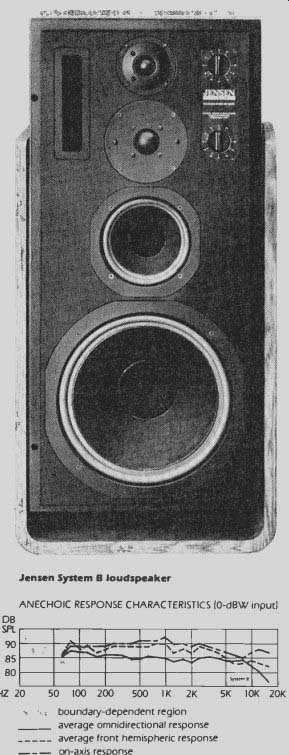Tradition Improved: Jensen's Best Yet
------------------------

ANECHOIC RESPONSE CHARACTERISTICS
10-dBW input
-. ts Z 20 50 100 200 500 1K 2K 5K 10K 20K boundary-dependent region average omnidirectional response average front hemispheric response
- on-axis response
AVERAGE OMNIDIRECTIONAL OUTPUT (250 Hz to 6 kHz) 85 dB SPL for 0 dBW ( 1 watt) input CONTINUOUS ON-AXIS OUTPUT (at 300 Hz) 110 dB SPL for 20 dBW 100 watts) input PULSED OUTPUT (at 300 Hz) ( 23 1/2 dB SPL for 33 1/2 dBW 12.280 watts) peak "NOMINAL" IMPEDANCE 6.3 ohms
APPROX. TWEETER CONTROL RANGE Ire "flat"( +1 1/2,-10 dB, above 9 kHz' APPROX. MIDRANGE CONTROL RANGE Ire "flat") +1,-6 dB, 1.5 to 6 kHz' see text
------------
Jensen System B floor-standing loudspeaker system in wood enclosure with variable-tilt base. Dimensions (including base): 16 1/2 by 33 3/8 inches (front), 11 3/8 inches deep. Price: $490. Warranty: "full," five years parts and labor.
Manufacturer: Jensen Sound Laboratories, 4136 N. United Parkway, Schiller Park, Ill. 60176.
Jensen's System B combines two elements not always found together in loudspeakers: good sound and attractive styling. Finished in a neutral brown, the enclosure sits in a natural-finish oak-veneer cradle that raises the speaker slightly off the floor and affords the user the option of tilting it slightly upward, should that help dispersion in his listening setup. Thus Jensen has gracefully avoided two extremes: the conventional "big box on end" look and the often outré radical alternatives.
Removal of the grille reveals four drivers mounted flush on the baffle, along with a vertically aligned vent and continuous-acting controls for midrange and treble. Mounted on the back of the speaker is still another driver, a 2-inch tweeter recessed into the cabinet and angled slightly upward, for improved high-frequency dispersion. The baffle-mounted drivers-a 1-inch soft-dome tweeter, a 1 1/4-inch soft-dome upper midrange, 6-inch lower-midrange driver, and 12-inch woofer-are precisely aligned on a vertical axis to lessen the propagation of interference patterns. The baffle board itself is built out from the cabinet, and the grille molding is recessed behind the front of the baffle to minimize reflection.
The "nominal" impedance rating, as determined by CBS Technology Center, is high enough to preclude problems with any modern amplifier, and impedance remains unusually consistent over most of the speaker's range. The system's high efficiency allows for the use of very low-powered amplifiers, yet it handled both the continuous-tone and tone-burst tests without the least sign of distress. Distortion at both moderate (0 dBW of input) and loud (100 dB of output) levels is very well controlled-quite low, in fact, for a system of this complexity. At 100 dB, the harsh-sounding third harmonic averages less than Yi% over much of the band and second harmonic is just a touch higher. With the 0-dBW input (for an output of approximately 85 dB), both second and third harmonic distortion average out to little more than 1/4%. The 300-Hz pulses are excellently reproduced, and though the 3-kHz pulse trace shows some evidence of low-level reflections, the effect is not severe enough to warrant concern.
Frequency response was measured in CBS's anechoic chamber with the tone controls set at "0", their flat positions. All three curves are quite flat and unusually smooth. The adjustments-both of which are calibrated at nominal settings of +2, 0,-6,-12,-16, and "low"-do little to improve the sound, in our opinion, and are rather inconsistent in their behavior; if both are set to "low," the results are very poor indeed. But at the "flat" settings, we were pleased by the rich, warm tonal balance of the System B and struck by its deep stereo imaging. Sounds appear to emanate from around and in front of the speakers, rather than from inside the enclosure. As we varied our position in relation to the stereo pair, the image held up well. The dynamic range is equally satisfying and quite exciting; sharp percussive sounds emerge with clarity and strength. The bass is especially noteworthy; the muddy thumping sound of so many vented speakers is here well controlled for crisp articulation.
Considered as a product of a company that for five decades has been turning out speakers, particularly bass reflex systems, the System B represents both a continuation and culmination. It is the top of Jensen's current line and, to our ears, the best speaker the company has ever made. At the same time (and despite many changes in both personnel and location), it is recognizably a Jensen in its warmth and solidity of sound: a tradition brought up to date, if you will.
(High Fidelity, Jan. 1980)
Also see:
SAE Two Model R-6 stereo FM/AM receiver